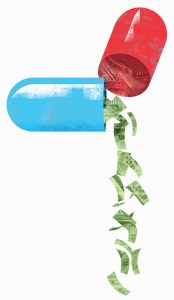A Woman’s Perspective: How to Save on Prescription Drugs

Even if you are not directly affected by the recent price hike of Mylan’s EpiPens to more than $600 each, you undoubtedly felt as I did when learning the news — shocked, enraged, and disgusted. Public outcry was understandably pervasive.
The truth is every day many people needing commonly prescribed medications are seeing the price for their month’s supply increase from just a few dollars to more than $100 a prescription. Most view these increases unfairly and feel as if they are being ripped off.
Consumer Reports National Research Center polls show spikes in prescription drug prices are happening nationwide. Drug prices vary from state to state, city to city, retailer to retailer — even within the same ZIP code. With prescription-drug spending expected to rise 7.3 percent a year through 2018, consumers whose insurance company ends or reduces coverage of a drug, and those without any coverage will continue to feel the pinch the most. Consumers with insurance may face higher out-of-pocket costs as co-pays and deductibles increase. Some will cut corners with their medication to make ends meet — splitting pills or skipping doses without their doctor’s OK. Others won’t fill their prescriptions.
Jumps in the price of drugs can result from a product shortage. It is also understood that other factors, including costs at the time the drugs were purchased from the supplier, manufacturer, or wholesaler, and pharmacy overhead and profit margins, may impact drug costs.
What colleagues and I find deeply concerning is the unsubstantiated price increase in everyday medications. I often treat a common aliment of pregnant women and seniors: hemorrhoids. Even if you take into account the issue of generics versus name brands, why does a box of 12 Anusol-HC, Anucort-HC or Rectacort-HC hydrocortisone suppositories, which recently cost under $50, cost $340 a box? Cream preparations that contain hydrocortisone 2.5 percent have also had inflationary increases, with products such as Proctozone-HC and Proctosol-HC now as much as $80 a tube. How is it that some local pharmacies quote these exorbitant price? Was there a run on the medicine? Is there a shortage? Is there a sudden increase in hemorrhoid patients? What explains a 580 percent increase? This is puzzling to me both as a physician and consumer.
Generic drugs experience price spikes, too, but they have a much lower cost and usually offer more options when their costs are temporarily inflated. Nearly eight out of 10 prescriptions filled in the United States are for generic drugs so be sure to talk to your doctor, who may be able to prescribe lower-cost generic alternatives.
For more ways to save money on your next prescription, remember:
• For drugs you take long term, seek a 90-day prescription if you can. It may be more convenient and cheaper, too. For example, if you use insurance, you’ll pay one co-pay rather than three.
• Never assume that one pharmacy’s “discounted” price is lower than another’s regular price. Prices and offers vary and change. Do comparison shopping.
• Big pharmacy chains typically charge higher for drugs. Some set their drug list prices high to help them determine what insurance companies will pay for a drug. Costco often has the lowest pharmacy chain prices; in most cases, you don’t need to be a Costco member to use its pharmacy (although joining can usually net you additional discounts).
• Local independent pharmacy and supermarket tend to offer bargains in drug prices. When asking for a lower price at an independent drugstore, you often have luck because the pharmacists might have more flexibility to beat or match competitor’s prices.
• There may be times you won’t want to use your health insurance. Consumers who pay out-of-pocket at many chain and big-box stores are often offered common generics at lower prices and sometimes that paid-out-of-pocket price is less than what their co-pay would be. Some pharmacists only process prescriptions through insurance unless told otherwise by customers so if you want to bypass your insurance, inform the pharmacist. Remember, money spent on your medication won’t count toward your out-of-pocket maximums or deductible when you bypass your insurance, and not all discount programs are open to people with Tricare Insurance, Medicare or Medicaid.
• Ask, “Is this your least expensive price?” Many pharmacists are prohibited from offering a better cash price to a customer unless a customer asks, so ask. In fact, asking may prompt the pharmacist to check and see if any coupons or discount programs are available. If you are paying out-of-pocket for your prescription, you might check a drug’s “fair price” on GoodRx.com and use it to negotiate if quoted a higher price.
• Sometimes you can fill a prescription cheaper using an online pharmacy. HealthWarehouse.com is an example of an online pharmacy that ships to all 50 states. Be sure to use only online retailers displaying the VIPPS (Verified Internet Pharmacy Practice Site) symbol. Be careful; some sites listing themselves as Canadian are fake and sell counterfeit or low-quality products. According to the National Association of Boards of Pharmacy (NABP), online pharmacies based in other countries that advertise deeply discounted medications are often not legitimate.
The Marin Independent Journal welcomed Dr. Lizellen La Follette as their health columnist from 2015-2018. Her A Woman’s Perspective column appeared every fourth week in the Journal during these 3 years.
